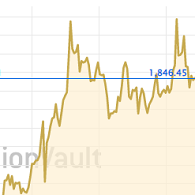Hey Gary, Why No 'Imminent' Concern?
SEC slip-up hints at fresh financial fears...
OOPS, says Adam Sharp in Addison Wiggin's Daily
Reckoning.
Last week the SEC accidentally published internal
commentary along with a speech by
Chair Gary Gensler. Here's one of the comments which was mistakenly included.
"I strongly recommend that a
sentence be placed here (or somewhere in the first part of the speech) to reassure markets that you are
not making the speech because
you think there is an imminent crisis."
These internal comms were quickly
deleted from SEC.gov, but not
before the page was archived for posterity. The slip-up reveals anxiety among regulators over
messaging.
Mr.Gensler's speech addressed financial crises, bank restructurings, and the importance of public
disclosures. In it, the SEC Chair
rightly argued that depositors need transparency to make good decisions.
"If a
large financial institution is
restructured, the market's need for disclosure doesn't go away. Indeed, I believe the market's need for
robust disclosure becomes all
the more critical. First, it is the best way to ensure that investors, counterparties, and depositors
will have sufficient confidence
to remain with the firm."
It's a solid point, transparency does need to
improve. But there's something else
missing here that we need to discuss.
Back in June, Daily Reckoning's Jim
Rickards warned that the banking
crisis may still have legs.
"Investors are relaxed because they believe the
banking crisis is over. That's a
huge mistake. History shows that major financial crises unfold in stages and have a quiet period between
the initial stage and the
critical stage."
In the article, Mr.Rickards pointed out a key flaw with
Mr.Gensler's argument that
transparency should allow depositors to make wise decisions. That flaw is the speed at which money moves
in today's world.
"On the other hand, this crisis could reach the acute stage faster. That's because of
technology that makes a bank run
move at the speed of light. With an iPhone, you can initiate a $1 billion wire transfer from a failing
bank while you're waiting in
line at McDonald's. No need to line up around the block in the rain waiting your turn.
"When a crisis hits,
rational analysis is often the first casualty. In this world where money moves in a blink, if you hear
about potential issues at your
bank, most of us aren't going to pull up its financial filings, spend hours analyzing them, and then
make a decision. We're going to
move it to a safer bank (or a mattress, or into gold) ASAP."
So while it is
good to hear that the SEC Chair
favors more transparency, it doesn't do much to allay our concerns. More disclosure could actually
accelerate a crisis due to the
velocity of information and money today. If a crisis hits, things can happen fast.
Let's get back to those
accidentally-published internal comments. An SEC staffer was concerned that Mr.Gensler's speech might
give the impression of an
"imminent crisis". Whenever regulators discuss the solvency of financial institutions there's a risk
that it is interpreted negatively
by markets. It's a valid worry.
Unfortunately, in this market, there are some
excellent reasons to interpret
the remarks in a cautious light. Let's start with the latest data on unrealized losses at
banks.

Remember when
this chart was making the rounds in 2022 and 2023?
The updated FDIC data
continues to show an unprecedented
and sustained rise in unrealized losses at banks. Notice how small the losses during the global
financial crisis appear in
comparison.
These are unrealized losses on banks' bond portfolios, primarily
caused by the Fed's rapid
interest rate hikes. When rates rise, the value of existing bonds (with lower yields than new bonds)
falls. This is what caused the
failure of Silicon Valley Bank.
Unrealized losses stand at $512 billion as
reported by the FDIC, down from a
peak of around $655 billion. The data has improved a bit, but bank balance sheets remain stressed at
historic levels.
Ongoing interest rate cuts should help stem the unrealized bleeding at banks. As rates
fall, the price of bonds will
rise. But lower rates should also mean lower profitability for the lending side of the business, so it's
somewhat of a double-edged
sword for banks.
Even if the unrealized loss situation gets resolved, there are
other potential black swans
to monitor. After all, why is the Fed planning to cut rates, apparently with haste? Are they simply
trying to get ahead of bank losses
and soaring debt servicing costs? Or do they potentially see a recession or financial crisis in the near
future?
Let's review our situation. The Fed is preparing for economic turbulence. Gold is trying to
tell us something as it
powers to new all-time highs. Job growth for the year was recently revised sharply downward. And now
regulators are making speeches
about restructuring large financial institutions.
It sure feels like
something's brewing. If you want to be
proactive and check your bank's unrealized loss ratio, you can use a free tool by Florida Atlantic
University. This screener isn't
perfect and doesn't tell you everything about a bank's health, but it's a start.
Besides moving to a better
bank, gold and silver remain an excellent way to prepare for potential calamities.













 Email
us
Email
us
